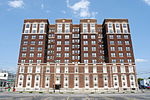Columbus College of Art and Design
1879 establishments in OhioArt schools in OhioColumbus College of Art and DesignDowntown Columbus, OhioEducational institutions established in 1879 ... and 2 more
Private universities and colleges in OhioUniversities and colleges in Columbus, Ohio

Columbus College of Art & Design (CCAD) is a private art school in Columbus, Ohio. It was founded in 1879 as the Columbus Art School and is one of the oldest private art and design colleges in the United States. Located in downtown Columbus, CCAD's campus consists of 14 buildings (including 2 residence halls) on 9 acres (36,000 m2) and is adjacent to the Columbus Museum of Art. Approximately 1,090 full-time students are enrolled.
Excerpt from the Wikipedia article Columbus College of Art and Design (License: CC BY-SA 3.0, Authors, Images).Columbus College of Art and Design
East Broad Street, Columbus
Geographical coordinates (GPS) Address Website External links Nearby Places Show on map
Geographical coordinates (GPS)
| Latitude | Longitude |
|---|---|
| N 39.964895 ° | E -82.989983 ° |
Address
Columbus College of Art and Design
East Broad Street
43216 Columbus
Ohio, United States
Open on Google Maps






